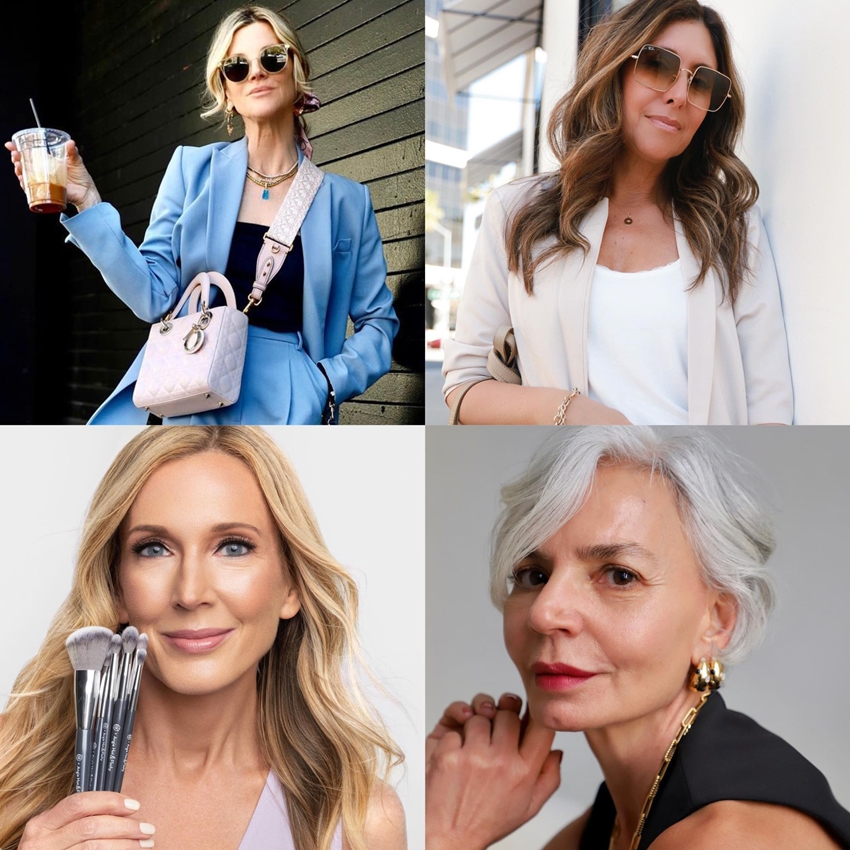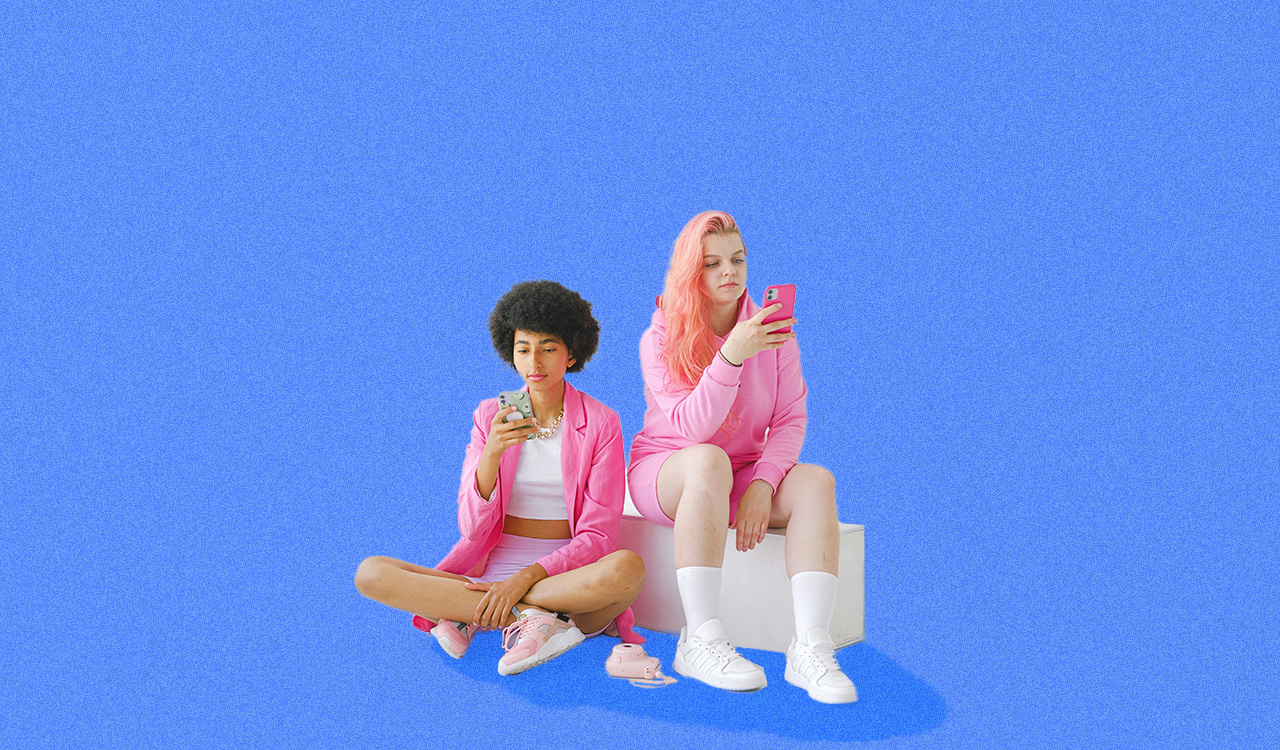Back in the olden days, women weren’t expected to look stop-traffic terrific at age 60. But try telling that to Janet “Grateful Gardenia” Gunn, an Instagram influencer with 100k followers who slays that idea every day. Gallivanting all over LA in a frisky mashup of high/low designer brands, she makes sure to swipe on her signature pinky-nude lip gloss before heading out the door. And on her Grateful Gardenia blog, she goes deeper on the products and brands she loves, including Beauty Pie Japanfusion Genius Lift Elixir, Westman Atelier Baby Cheeks Blush Stick and Soma Ayurvedic Jasmine Body Oil.
Aging is Relative on Social
I’m just a year younger than Gunn, and for the most part I find the content she produces uplifting and aspirational; she’s truly gorgeous and her style is impeccable. Still, seeing Gunn’s posts, as well as those of the even more beauty-savvy, 57-year-old Melissa “The Glow Girl” Meyers, makes me wonder: Do we women now literally never get to stop worrying about our looks?
Videos created by attractive people get more views. Thus, it’s a never-ending hamster wheel of attractive person video, dopamine hit, attractive person video. No wonder our perception of reality is becoming so skewed and our attention spans so short.
While much has been written, and for good reason, about the psychological havoc social media is wreaking on young women, I wanted to know what it was doing to women in my own age cohort. Are we as susceptible to body dysmorphia and low self-esteem as millennials and Gen Z?
My first stop: high-profile female shrink Gail Saltz. As clinical associate professor of psychiatry at New York Presbyterian Hospital and host of the iHeart Radio “How Can I Help?” podcast, I knew the good doctor could set me straight.
But before I dive into Saltz’s thoughts, and her excellent advice for cusp-of-Boomer women like me, please allow me to start pointing a few fingers.
Is TikTok the Core Problem?
At the risk of sounding hopelessly behind the curve, I partake in exactly two social media platforms, and TikTok isn’t one of them.
Which I’m starting to think is actually brilliant on my part, because out of all of the platforms that can contribute to making us feel really lousy about ourselves, the highly visual, viral, video centric TikTok may be the worst.
Because I have no clue as to how TikTok actually works, I dove into a really excellent two-part blog post on the topic on the Psychology Today website.
Evidently videos, which are limited to 60 seconds, can go viral much faster on TikTok than on any other platform. For now, all the other platforms are currently playing catch-up with their own ever-shorter posting options. And according to Psychology Today, content creators experience a release of dopamine when they see that one of their videos gets hundreds or thousands of views. That leads to the creation of more videos.
No surprise here: videos created by attractive people get more views. Thus, it’s a never-ending hamster wheel of attractive person video, dopamine hit, attractive person video. No wonder our perception of reality is becoming so skewed and our attention spans so short.
Worse, it may be leading young viewers to develop eating disorders, harm themselves and even commit suicide. Thankfully the U.S. government is aware of this. Early in March, it was announced that attorneys general from eight states, including California and Florida, were launching a nationwide probe into the effect of TikTok on young users’ mental health.
At least for now, says Saltz, TikTok is not huge among my age group. “Gen Z and millennials are on visual social media like TikTok much than over-50s in general,” she notes. “The more time spent pondering body images of others with an eye towards being the most attractive, the more likely you are to be affected by the comparisons to yourself and the underlying message, which is often that you’re not measuring up.”
Note to self: stay off TikTok.
Scroll at Your Own Risk
There’s zero question that the proliferation of older influencers like Gunn, Meyers, Grece Ghanem and Angie “Hot and Flashy” Schmitt is advantageous for Big Beauty. After all, the more product reviewed and promoted on social media, the better, right?
While she says she’s inspired by “many women on social media, regardless of age,” beauty industry publicist and newly minted retailer Dianne Vavra, 55, holds a special spot in her heart for influencers close to her own age. “When I see a great-looking woman who is older,” Vavra admits, “I feel a wave of comfort that makes me feel less afraid of aging.”
Throughout nearly two decades in P.R. at LVMH-owned Dior before going out on her own, Vavra interacted with a slew of celebrities, including spokesperson Sharon Stone. Those years helped her hone a certain discipline to forego comparing herself to others. “I take Mel Robbins’ advice and when I start picking myself apart, I say in my head, ‘I’m not thinking about that!’ and I move on. I’ve learned over the years, working up close with gorgeous models and actresses, not to compare myself, but to be myself, accept myself and honor my flaws.”
If only more 50+ plus women could do that, too. “Most humans value attractiveness and therefore place much – too much – value in measuring up with appearance,” says Saltz. And while those with a predisposition toward perfectionism, anxiety, depression and other mental health issues can be especially triggered by social media, not a single one of us is immune. “We are very youth-centric culture, youth is revered here, making it harder for women to feel valued and old.”
Saltz says we all need to be mindful of the toll mindless scrolling can exact on our psyches. “If social media is making you consumed with your looks and hurting your confidence definitely change what you look at, change your content or stop,” altogether, she says. “Spend time thinking about what you most value in life, and in people, and then in yourself and focus on developing and appreciating those things.”
Such as? “Health and strength, intellect, social relationships, productivity, family. It may even be looking great in your age range, but not as a 30-year-old would look.”
Until we 50+ females become sufficiently enlightened, and able to psychologically untether ourselves from the notion that we must stay perpetually youthful and alluring, brands and influencers will continue to have ample opportunity to sell to us. And according to an oft-cited study, the numbers are huge; an American woman spends an average of $3756 annually on beauty (both products and services), for a whopping $225,360 over the course of her lifetime. One can only assume that women with larger disposable incomes and infinitely more lines and wrinkles are spending that and then some. So, unless we Zen out and consciously take ourselves inward, there’s a spot on the social-video hamster wheel with our names written all over it.
Industry Takeaways
As older beauty influencers continue to gain clout, here are three ways brands can maximize alliances and collaborations with them:
- If you’re still using the term “anti-aging” in any way, stop. Top influencers are now routinely shunning collaborations with brands that promote the idea that getting older is somehow bad. The one exception to this rule? Hot and Flashy’s Schmitt, who still uses “anti-aging” in her social media taglines.
- Get comfy with Facebook and YouTube. While not as peppy and hip as TikTok or as gorgeously curated as Instagram, Facebook and YouTube are massive faves with the 50+ crowd, who love the low-key accessibility of the former and the preponderance of “how to use it” tutorials on the latter.
- Choose your influencers wisely: With a pool of so many top-notch older influencers now, brands can afford to be choosy. Home in on those who are truly relatable and whose content demonstrates they know what they’re talking about. In posts about skincare, are they describing ingredients and benefits in a way followers can understand? If they’re raving about makeup, are they willing to share both “before” and “after” shots? Never discount the power of bare-faced vulnerability.




